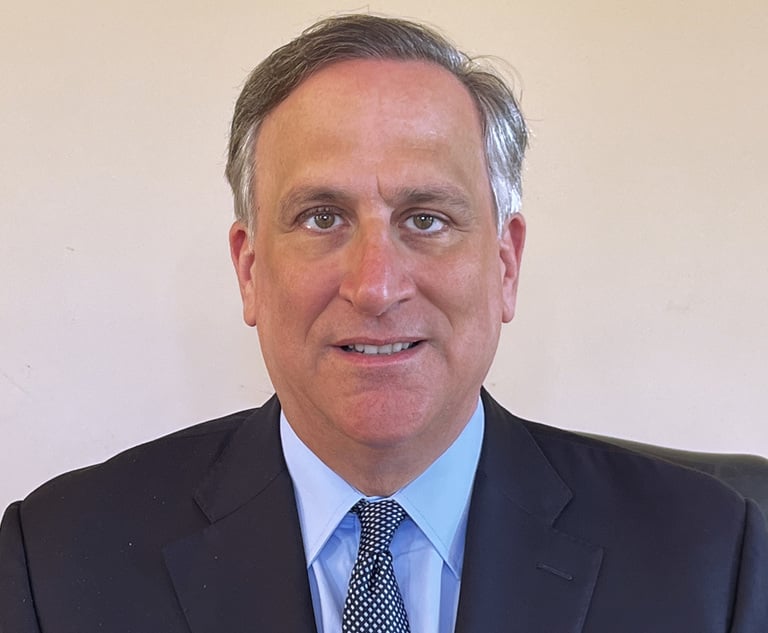COVID-19 and DNRs: A Fatal Combination
Should the medical profession weigh its well-settled approach to resuscitating a dying patient against the real danger of exposing doctors and nurses to COVID-19?
March 31, 2020 at 02:36 PM
9 minute read
 Former Connecticut Supreme Court Justice and DCF Commissioner Joette Katz.
Former Connecticut Supreme Court Justice and DCF Commissioner Joette Katz.
I was reading an article recently by a woman whose father is a doctor dying from COVID-19, contracted from a patient whom the doctor was desperately trying to resuscitate. Doctors and nurses have been trained to "save at all costs," or at least to do everything they can, absent a DNR, within the bounds of modern technology to save a patient's life. It's a model whose origin is an amalgam of morals, empathy, science, laws, values and the Hippocratic Oath, but it's a model that is quietly being called into question. Indeed, there is now a debate that is going on at hospitals where that approach is being questioned-or at least examined. Should the medical profession weigh this well-settled approach to resuscitating a dying patient against the real danger of exposing doctors and nurses to COVID-19?
We've all watched enough television to have seen a Code Blue scenario—you know, the one used to signal that a patient has gone into cardiopulmonary arrest. It is the Code Blue process that puts health care providers at an enhanced risk because it involves chest compressions that are part of cardiopulmonary resuscitation or CPR, punctures to the neck and arms to access blood vessels to put in new intravenous lines, epinephrine injectors and a defibrillator to restart the heart. These emergency procedures can include endoscopies, bronchoscopies and other procedures in which tubes or cameras are sent down the throat, often sending virus-laced droplets from a patient's airways all over the hospital room. In the process, providers use many gloves, gowns, masks and other protective equipment. (See C.G.S. sec.19a-580d (a) "'DNR order' means an order written by a physician licensed under chapter 370 or advanced practice registered nurse licensed under chapter 378 for a particular patient to withhold cardiopulmonary resuscitation of such patient, including chest compressions, defibrillation or breathing, or ventilation of such patient by any assistive or mechanical means, including, but not limited to, mouth-to-mouth, bag-valve mask, endotracheal tube or ventilator".)
Necessity is the mother of invention and so I think it's safe to say that discussions are occurring now, indeed occurring with increased frequency, because of the extreme shortage of protective equipment that would otherwise allow doctors and nurses to follow the conventional response when a patient has stopped breathing or the heart has stopped beating. As COVID-19 cases mount amid a national shortage of protective equipment, hospitals are beginning to consider whether to implement emergency measures that will either minimize, modify or completely stop the use of certain procedures on patients with the virus.
At universities like University of Pennsylvania among people like Ezekiel Emanuel, vice provost for global initiatives and chairman of the Department of Medical Ethics and Health Policy at the University of Pennsylvania, there have been philosophical and ethical debates about equipment shortages and the impact that these shortages can have on deciding who should be saved. It's difficult enough to have these discussions in a vacuum, but having to make actual decisions to ration equipment among critically ill patients could be devastating, particularly if the patients are equally likely to benefit. These conversations need to be transparent, lead to saving as many lives as possible, and ensure that there are no inappropriate considerations such as wealth, race, ethnicity or politics to influence allocation of lifesaving resources.
We have experience to draw upon and understand that rationing care is a model long used for organ transplantation (organs are allocated by strict rules that consider physical matching, tissue and blood type matching, medical criteria, waiting time, severity of illness, etc.) and in wartime (triage is the process of sorting casualties according to severity of injury and prioritization of treatment: emergent, urgent and not urgent). This will mean that instead of providing the most intensive care to all patients who need it, it may become necessary to follow this most widely shared criterion regarding distributive justice and the appropriate allocation of limited health resources.
What I'm speaking to in this article, however, is not simply the idea that daily equipment decisions could soon be made like a lottery, although that is certainly daunting enough. Rather, what I'm addressing is whether there will shortly be a need for health care providers to change well established DNR procedures, changing in essence how medicine is practiced. Many hospitals around the country whose spokespersons are being questioned acknowledge that these conversations are indeed taking place but add that there are no plans for their staff to override patient or family wishes. They are extremely cautious about deviating from their well-established obligations in similar end-of-life situations. Others expressly add that they do not foresee a universal do-not-resuscitate approach that would ignore age and other health issues.
Some point out that a patient's wishes are always balanced against the reality of whether the request will likely not be helpful. Some hospitals will continue to resuscitate COVID-19 patients using modified procedures, such as putting plastic sheeting over the patient to create a barrier. Other hospitals indicate that they will deal with the problem by severely limiting the number of responders to a contagious patient in cardiac or respiratory arrest. (Typically when a Code blue alarm is activated, all available personnel, often in the double digits, converge.) Some hospitals are looking to provide guidelines that would allow their doctors to override the wishes of the COVID-19 patient or family members on a case-by-case basis due to the risk to their medical providers, or a shortage of protective equipment. Their concerns are not just about health-care workers getting sick—although that is bad enough—but also about them potentially carrying the virus to other patients in the hospital. What has been sacred for decades may now actually be called into question, and institutions will be making decisions not at a national level but based on different infection rates and different resources—institution by institution.
Hospitals recognize that changing or eliminating their standard protocols will likely decrease some patients' chances for survival, but they insist that the measures are necessary to save the most lives. There is also the reality that by the time the medical providers get all gowned up and gloved the patient could be dead, and the providers will be coding dead people. Most hospitals questioned agree they would not impose a do-not-resuscitate order on every coronavirus patient; that approach would be far too draconian and could result in the death of someone who is otherwise in good health. And some caution that a blanket DNR order could open the door to insidious decision-making for subgroups of patients or patients with particular conditions being viewed as reasonable. And while no one wants to let that camel's nose under the tent, virtually all hospital administrators who were questioned cautioned that the safety of health-care workers and that of other future patients, as well as limited protective equipment, cannot be ignored.
We may soon be faced with an old question (long ago put to bed in Connecticut) about how the standard of care should be determined—whether by the standards of a geographically circumscribed subset of similar specialists, or by nongeographic or national standards of the particular specialties. While a minority of courts may still take the position that a doctor should be held to the standards of similar specialists practicing in the same community, reasoning that a physician or surgeon who practices in a small or rural community does not have the same opportunities and resources for keeping abreast of the advances in medical science as do the doctors practicing in the larger and more sophisticated cities, the majority of courts have held that a national or nongeographic standard of care should apply for all medical specialists because the lack of opportunity to keep up with modern trends is no longer valid in an age of ubiquitous national communication networks, increasing standardization of medical and specialist training and equipment, readily available scientific information among medical institutions throughout the country, and professional journals and numerous other networks of continuing education which are national in scope. See Logan v. Greenwich Hospital, 191 Conn. 292 (1983) ("Under contemporary conditions there is little reason to retain this vestige of former times when there was a substantial basis for believing that the rural doctor should not be held to the standards of the urban doctor, since the latter had greater access to new theories and had more opportunity to refine his method of practice. We are not aware of any differences in the educational background and training of physicians practicing in Connecticut compared with those in other states. Medical literature of significance is normally disseminated throughout this country and not confined to a particular state. We align ourselves with many other jurisdictions which have in recent years abandoned similar geographical restrictions in medical malpractice cases.") Whether that issue is revisited in the context of care and treatment of COVID-19 remains to be seen, but when hospitals are called to respond at different rates (New York City vs. anywhere in Montana), it seems highly likely.
All these discussions will ultimately give rise to a new set of guidelines for the medical profession and concomitant issues for lawyers representing the estate of anyone who had COVID-19 and whose life was not saved when he coded, or the estate of someone who contracted the virus as a consequence of a procedure used to save one patient that put others at risk. Of course the issues of whether the procedure was necessary, or reasonable (successful or not), done without all the necessary protection, etc. could result in a whole new body of jurisprudence. So too will decisions involving limited equipment that get made based on a utilitarian model, favoring those with the best prospects for the longest remaining life. And lawyers representing hospitals will wrestle with these same issues as well as face others linked to federal regulations, ensuing federal funding, etc.
Health economists as well as ethicists have thought about how to allocate finite health care resources and now they, along with medical professionals, are talking as well about medical procedures like DNRs. I think we can all agree it would be better to have these conversations around evolving guidelines as an academic exercise, but that's a luxury we can no longer afford. For now, the decisions will in large part come down to a hospital's resources and the existing protocols in place, but changes are inevitable.
This content has been archived. It is available through our partners, LexisNexis® and Bloomberg Law.
To view this content, please continue to their sites.
Not a Lexis Subscriber?
Subscribe Now
Not a Bloomberg Law Subscriber?
Subscribe Now
NOT FOR REPRINT
© 2025 ALM Global, LLC, All Rights Reserved. Request academic re-use from www.copyright.com. All other uses, submit a request to [email protected]. For more information visit Asset & Logo Licensing.
You Might Like
View All
ADVANCE Act Offers Conn. Opportunity to Enhance Carbon-Free Energy and Improve Reliability With Advanced Nuclear Technologies

Trending Stories
- 1Litigators of the Week: A Knockout Blow to Latest FCC Net Neutrality Rules After ‘Loper Bright’
- 2Litigator of the Week Runners-Up and Shout-Outs
- 3Norton Rose Sues South Africa Government Over Ethnicity Score System
- 4KMPG Wants to Provide Legal Services in the US. Now All Eyes Are on Their Big Four Peers
- 5Friday Newspaper
Who Got The Work
Michael G. Bongiorno, Andrew Scott Dulberg and Elizabeth E. Driscoll from Wilmer Cutler Pickering Hale and Dorr have stepped in to represent Symbotic Inc., an A.I.-enabled technology platform that focuses on increasing supply chain efficiency, and other defendants in a pending shareholder derivative lawsuit. The case, filed Oct. 2 in Massachusetts District Court by the Brown Law Firm on behalf of Stephen Austen, accuses certain officers and directors of misleading investors in regard to Symbotic's potential for margin growth by failing to disclose that the company was not equipped to timely deploy its systems or manage expenses through project delays. The case, assigned to U.S. District Judge Nathaniel M. Gorton, is 1:24-cv-12522, Austen v. Cohen et al.
Who Got The Work
Edmund Polubinski and Marie Killmond of Davis Polk & Wardwell have entered appearances for data platform software development company MongoDB and other defendants in a pending shareholder derivative lawsuit. The action, filed Oct. 7 in New York Southern District Court by the Brown Law Firm, accuses the company's directors and/or officers of falsely expressing confidence in the company’s restructuring of its sales incentive plan and downplaying the severity of decreases in its upfront commitments. The case is 1:24-cv-07594, Roy v. Ittycheria et al.
Who Got The Work
Amy O. Bruchs and Kurt F. Ellison of Michael Best & Friedrich have entered appearances for Epic Systems Corp. in a pending employment discrimination lawsuit. The suit was filed Sept. 7 in Wisconsin Western District Court by Levine Eisberner LLC and Siri & Glimstad on behalf of a project manager who claims that he was wrongfully terminated after applying for a religious exemption to the defendant's COVID-19 vaccine mandate. The case, assigned to U.S. Magistrate Judge Anita Marie Boor, is 3:24-cv-00630, Secker, Nathan v. Epic Systems Corporation.
Who Got The Work
David X. Sullivan, Thomas J. Finn and Gregory A. Hall from McCarter & English have entered appearances for Sunrun Installation Services in a pending civil rights lawsuit. The complaint was filed Sept. 4 in Connecticut District Court by attorney Robert M. Berke on behalf of former employee George Edward Steins, who was arrested and charged with employing an unregistered home improvement salesperson. The complaint alleges that had Sunrun informed the Connecticut Department of Consumer Protection that the plaintiff's employment had ended in 2017 and that he no longer held Sunrun's home improvement contractor license, he would not have been hit with charges, which were dismissed in May 2024. The case, assigned to U.S. District Judge Jeffrey A. Meyer, is 3:24-cv-01423, Steins v. Sunrun, Inc. et al.
Who Got The Work
Greenberg Traurig shareholder Joshua L. Raskin has entered an appearance for boohoo.com UK Ltd. in a pending patent infringement lawsuit. The suit, filed Sept. 3 in Texas Eastern District Court by Rozier Hardt McDonough on behalf of Alto Dynamics, asserts five patents related to an online shopping platform. The case, assigned to U.S. District Judge Rodney Gilstrap, is 2:24-cv-00719, Alto Dynamics, LLC v. boohoo.com UK Limited.
Featured Firms
Law Offices of Gary Martin Hays & Associates, P.C.
(470) 294-1674
Law Offices of Mark E. Salomone
(857) 444-6468
Smith & Hassler
(713) 739-1250












